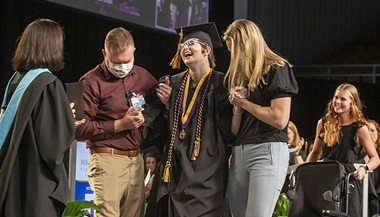Arachnoid Cysts
What is an arachnoid cyst?
Arachnoid cysts are the most common type of brain cyst. They are often congenital, or present at birth (primary arachnoid cysts). Head injury or trauma can also result in a secondary arachnoid cyst. The cysts are fluid-filled sacs, not tumors.
The likely cause is a split of the arachnoid membrane, one of the three layers of tissue that surround and protect the brain and spinal cord.
What You Need to Know
- Arachnoid cysts occur in one of the three layers of tissue that surround the brain and spinal cord.
- Most arachnoid cysts are stable and do not require treatment.
- They are four times more common in boys than in girls.
- Arachnoid cysts are diagnosed with a CT or MRI scan.
- Treatment, if necessary, involves draining the fluid through surgery or shunting.
Symptoms of an Arachnoid Cyst
Some arachnoid cysts never present a problem, but others can cause symptoms by putting pressure on the brain. Depending on the size and location of the arachnoid cyst, symptoms can include:
- Headache
- Nausea and vomiting
- Lethargy, including excessive fatigue or low energy
- Seizures
- Visible lumps or protrusions from the head or spine
- Developmental delays
- Hydrocephalus due to obstruction of normal cerebrospinal fluid circulation
- Endocrine (hormone-related) issues, such as early onset of puberty
- Involuntary head bobbing
- Vision problems
Arachnoid Cyst Diagnosis
CT or MRI scans will help the surgeon see the location and characteristics of an arachnoid cyst, then determine the most appropriate treatment for your child.
Arachnoid Cyst Treatment
Arachnoid cysts — even large ones — that do not cause symptoms or put pressure on the brain or spinal cord do not require treatment.
The main goal of arachnoid cyst treatment is to drain fluid from the cyst and relieve pressure. This can be accomplished through several treatment options:
Craniotomy
Your child’s surgeon may recommend a craniotomy (surgically creating an opening in the skull) to make openings in the cyst wall (a process called fenestration) and ensure normal flow of cerebrospinal fluid.
This is a more invasive procedure but allows the neurosurgeon to directly inspect and address the cyst. Rarely, the cyst refills with fluid and needs to be treated again.
Shunt
Shunting of an arachnoid cyst is another option. The surgeon inserts a tube into the cyst, which remains in place and allows the fluid to drain away and be absorbed elsewhere in the body.
However, your child may become dependent on the shunt to keep symptoms from returning, and living with a shunt can cause complications, such as blockage or infection.



